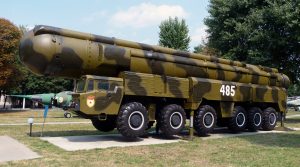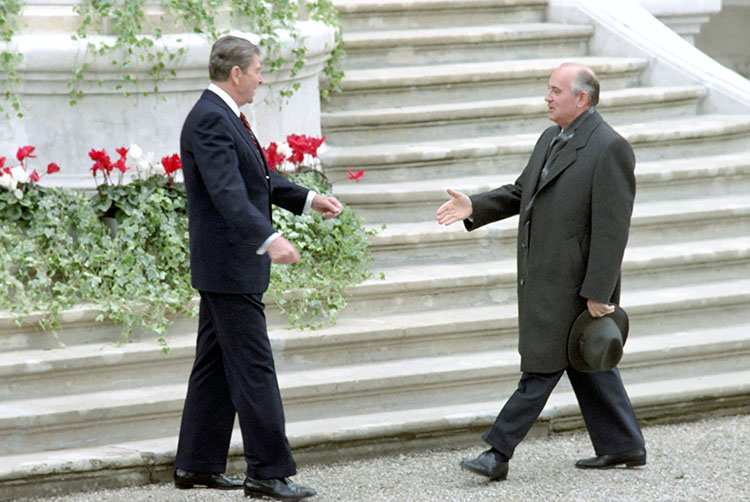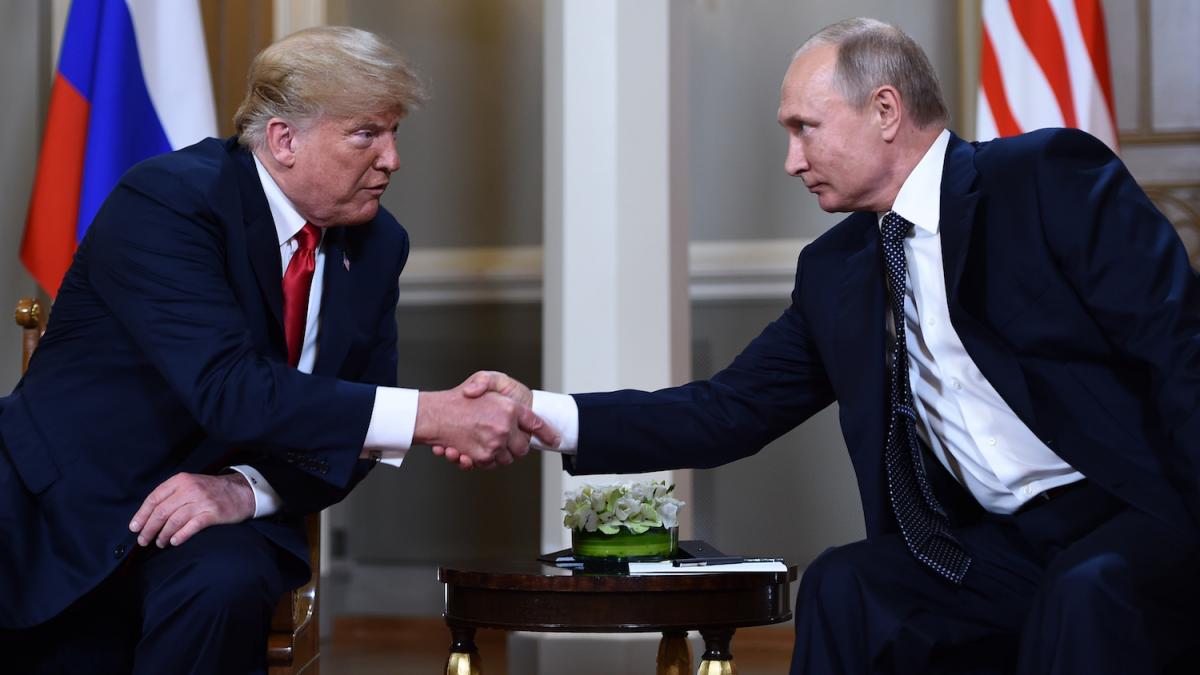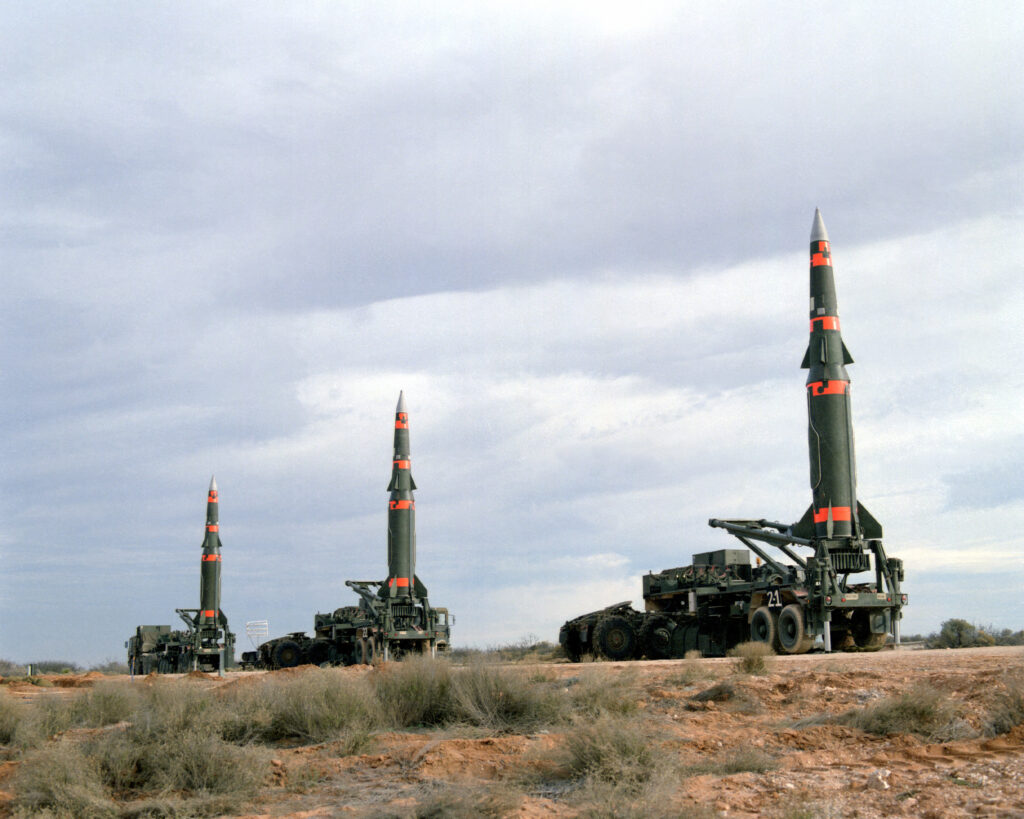Will The Army’s 1,000-Mile Missiles Kill Reagan’s INF Treaty?
Posted on
WASHINGTON: The arms control community is up in, well, arms over the Army’s plan for missiles with a thousand-mile range. Such weapons could blow holes in Russian or Chinese defenses in a major war – but their first victim may well be an ailing arms control agreement, the INF treaty.
[Click here to read our entire series on the Army’s plan for ultra-long-range missiles]
The fundamental questions:
- Is it worth trying to save the treaty, even though the Russians are cheating and the Chinese never signed?
- Is it better to void a treaty that binds our hands and build new weapons, even at the risk of an arms race?
- Could we do both at once, the way Ronald Reagan deployed the nuclear-tipped Pershing II to Europe – tremendously controversial at the time – to successfully pressure the Soviets into signing the INF treaty in the first place 30 years ago?
- Would such a peace-through-strength approach only alienate our allies and scare today’s more volatile Kremlin into doing something dangerous?
At stake is the 1987 Intermediate-Range Nuclear Forces (INF) accord, which banned ground-launched weapons with ranges between 500 and 5,500 kilometers (312 to 3,338 miles). That left both sides’ strategic nuclear deterrents and tactical rocket artillery intact, but it dismantled the most destabilizing weapons, like the US Pershing II and the Russian SS-20: mid-range missiles, based in Western or Eastern Europe, that could reach Moscow or NATO capitals with only a few minutes’ warning.
“Trump Is No Reagan”
Congress, for its part, is fed up with Russia. It recently passed a 2019 defense bill that includes a non-binding Sense of Congress to encourage (but does not require) the administration to “suspend” the INF treaty and work on new weapons. That builds on an earlier provision in the 2016 bill encouraging (but not funding) the Pentagon to study “counterforce capabilities to prevent intermediate-range ground-launched ballistic missile and cruise missile attacks, (and) countervailing strike capabilities… whether or not such capabilities are in compliance with the INF Treaty.”
“Look, the Obama administration indicated that Russia was in violation of the INF Treaty four years ago,” said a staffer from the House Armed Services Committee.
So it’s not Congress that lacks respect for the treaty, it’s Russia, and we need to act. “That treaty is a cornerstone of our national security and European security,” the staffer told me. “If the treaty’s being violated, we have to take steps to ensure that stability some other way…. As they have done throughout their history, hopefully they will respect strength when they choose to disregard law.”
Will this work? “Putin is no Gorbachev and Trump is no Reagan,” said Alexandra Bell, a former State Department official now with the Center for Arms Control & Non-Proliferation. We can try to replicate the 1980s’ power play, she said, “but it’s a really large gamble….with the way our alliances have been weakened – by choice on the part of the US president – that we’d be able to replicate the breakthrough that happened at Reykjavik.”
On the upside, there is one big positive difference between then and now. In the 1980s, the US Army was deploying nuclear weapons. Today, it’s just talking about conventional explosives. These would be precision weapons to take out military targets with (hopefully) a minimum of collateral damage, not weapons of mass destruction.
But in interviews with arms control experts, they kept coming back to the nuclear implications. Why?
Despite its name, the Intermediate-Range Nuclear Forces (INF) accord restricts conventional weapons too, because it bans wide categories of missiles that could carry a nuclear warhead. One no-longer-valid reason is that, back in 1987, almost all such missiles were nuclear because precision guided munitions were new and unproven. Historically, anything you fired 1,000 miles would be so inaccurate you’d need a nuke to ensure you hit the target, like hitting a bulls-eye with a bulldozer.

Soviet SS-20 (SRD-10) Intermediate Range Ballistic Missile (IRBM) on its road-mobile Transporter-Erector-Launcher (TEL).
But even today, when you can target precisely enough over such distances to make a nuclear warhead unnecessary, there’s no way the enemy can tell whether the warhead was a nuke or not until it hit. Russia or China could mistake a salvo of incoming conventional weapons for a nuclear strike and launch Armageddon in response.
The Army insists these missiles won’t have nuclear warheads, I repeated with increasing frustration. They won’t even be the same kind of missile the US uses for nukes, flying different profiles that are visible on radar. Theoretically, we could develop a nuclear variant in secret, but….
Then it hit me: If I can’t convince American arms control experts that these will never be nukes, how can the US government convince the Russians?
“You’re asking for trust,” Bell told me. “For that kind of trust to be there, you need conversations to be ongoing, mil-to-mil (between the US and Russian militaries), which are just not happening.”
What’s Banned, For Whom?
Despite the “N” in its name, the INF treaty bans any US or Russian ground-launched missile, ballistic or cruise, that could carry a nuclear warhead between 500 and 5,000 kilometers, even if it’s conventionally armed. In other ways, the INF is strangely narrow. It only governs ground-based weapons, not ones launched from aircraft, ships, or submarines.
The Kremlin has long said this formulation favors the US, with its globe-spanning air- and seapower, over the largely landlocked Russians. No less a figure than the Vice-Chairman of the Joint Chiefs of Staff, Gen. Paul Selva, has told Congress the US has enough air- and sea-launched systems to maintain the military balance with both Russia and China.
But many military leaders worry that increasingly sophisticated adversaries can hold US aircraft, ships, and even subs at bay with their own long-range smart weapons. These Anti-Access/Area Denial (A2/AD) threats would make a mobile land-based launcher an attractive backup. Such weapons could be cheaper, more numerous, and more concealable than planes or naval vessels, basically launcher trucks that could hide out in tunnels or jungle islands, then roll out to retaliate.
“Right now, we are almost completely dependent on air forces and aviation assets in order to attack the A2/AD problem,” retired NATO supreme commander Philip Breedlove said in 2016. “I submit – my opinion – that we need more long-range, survivable, precision-strike capability from the ground.”
China is particularly important here because the INF treaty only binds the US and the Soviet Union’s successor states (effectively, Russia). China was never asked to sign. It’s also invested massively in the very class of weapons the INF Treaty forbids: ground-based ballistic and cruise missiles with ranges of roughly 300-3,000 miles.
Now, China maintains a much smaller nuclear arsenal that either the US or Russia, so the vast majority of these weapons have conventional warheads. But the Chinese arsenal today poses the same dilemma as the proposed US weapons could pose in future. You never know for sure whether the incoming warhead is a nuke or not until it hits.
In contrast to China’s massive arsenal, Russia appears to have only a single intermediate-range, ground-launched cruise missile, the 9M729. Like many Chinese missiles, but unlike the proposed US ones, these are so-called dual-capable weapons that could carry either a nuclear warhead or a conventional one. Unlike China, but like the US, Russia is bound by the INF Treaty, so the Russian missiles are illegal.
At least the Russian violation is relatively small, so far, compared to the Cold War arsenals the INF disbanded. Arms control experts fear that if the US undermines or outright abandons the treaty, Russia will respond without restraint.
“Even if they’re violating, they’re somewhat constrained,” said Lynn Rusten, a former NSC and State Department staffer now with the Nuclear Threat Initiative. “I worry about a mutual decision to withdraw from the treaty and then all bets are off… If there were no treaty, there’d be no limits.”
Can We Talk?
Can the US get the Russians to get rid of their INF-violating weapons without building treaty-busters of our own?
“I don’t know,” said NTI’s Rusten. “But my sense is they’re starting to have a greater appreciation for the cost of this violation now that it’s been exposed, (that) a classic arms race situation may not benefit their security.”
“They are making some hints now they’re willing to have serious conversation about it,” Rusten continued. “For instance, people who are close to the government are floating ideas that they’re willing to have it inspected.” Allowing visual inspection of the missile wouldn’t do much by itself, she said, but it’s a big improvement over Moscow’s previous insistence the 9M729 did not exist and could open the door to real concessions later on.
Another positive sign, added Bell, is that in Putin’s March speech boasting of the Russian arsenal, one weapon system he did not talk up was the 9M729. “It kind of got lost in the whole simulated bombing of Mar-a-Lago,” she told me, “(but) he talked about the development of new cruise capabilities and how probably they didn’t even need them because of all these new strategic weapons.” That at least suggests the INF-violating missile is a potential negotiating chip.
“We ought to be putting our efforts at the moment to bring Russia in compliance,” said Rusten. In fact, she and Bell both argued, the US can allay a lot of Russian concerns without giving up anything, by guaranteeing the Aegis Ashore missile defense systems now being built in Poland and Romania won’t be used as offensive weapons. “That’s clearly not our plan,” Rusten said, so why not reassure the Russians by, say, allowing them to inspect the Aegis sites if we get to inspect the 9M729s?
“So long as Russia remains in violation of the treaty, the United States should make it clear to Russia that it will not be allowed to gain a military advantage from its violation,” said Kingston Reif, director of disarmament for the Arms Control Association. That could include economic sanctions, reinforcing US missile defenses in Europe, or even deploying some of the many offensive weapons we have or can develop that don’t violate the treaty, he told me. But let’s not tear the treaty up, he said, or give the Russians an excuse to.
“We need to continue to work to preserve the treaty,” he said. “The costs, in my view, of abrogating the INF Treaty outweigh the potential benefits of these additional capabilities.”
[Click here to read our entire series on the Army’s plan for ultra-long-range missiles]
Subscribe to our newsletter
Promotions, new products and sales. Directly to your inbox.








